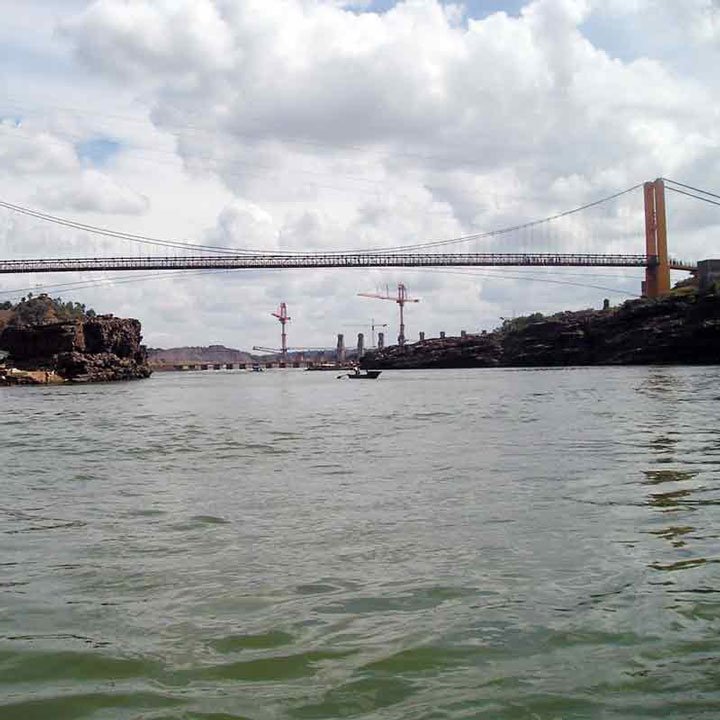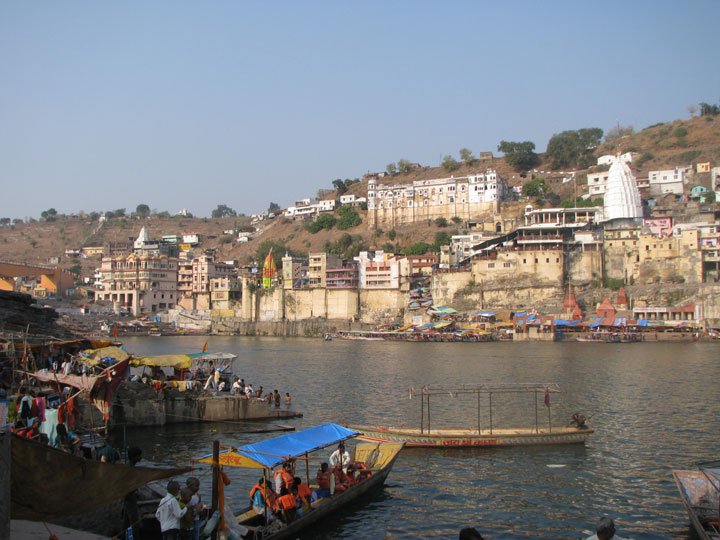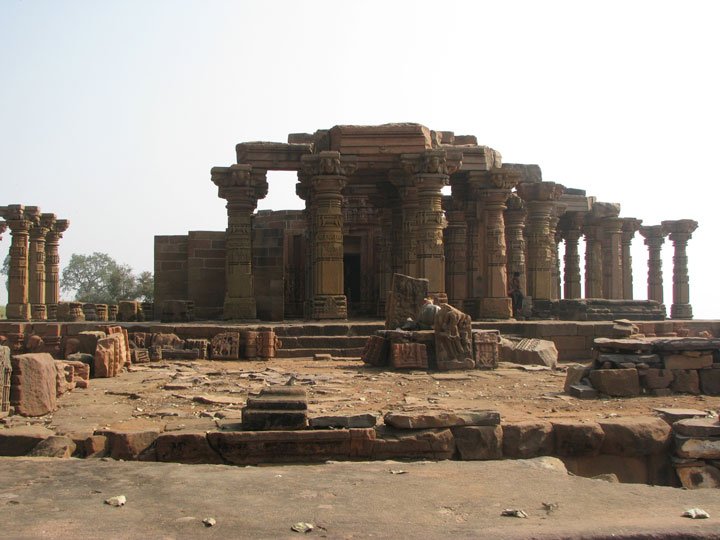Omkareshwar – the island abode of Lord Shiva
Posted on October 29, 2019 by Ghoomophiro
Having a temple that is shaped like Om, Omkareshwar is of great spiritual importance to Hindus as well as offering a great aesthetic pleasure to secular travelers too.
The temple is located in a ridiculously small island lies on the river Narmada and its tributary Kaveri. It is also called Mandhata and Shivpuri but is popularly called Omkareshwar after its grandest temple.
What is the best time to visit
The extreme of summer (and preferably that of winter) should be avoided while visiting Madhya Pradesh. October-November is the best months to visit. Also, you may want to visit Omakareshwar on its two annual festivals – Narmada Jayanti and Mahashivratri. Omkareshwar and Maheshwar have their ghats adorned with lights and maha parties are performed at these ghats.
How to reach Omkareshwar?
Omkareshwar is not really well connected to the rest of the world. The nearest airport and railway station are both at Indore which is 78 kilometers away. From there you can catch the bus to the banks of the Narmada river. You can also catch a bus from Ujjain and Khandwa. We can’t say we liked the journey by bus a lot but it was worth the experience Omkareshwar had to offer. Once you have reached the shores of Narmada river, a streamer will take you to the island.
We highly recommend that you visit Omkareshwar when you are touring Indore – as a one day detour along with Maheshwar or a two-day detour that would include Omkareshwar, Maheshwar and Mandu.
Where to stay in Omkareshwar?
Like most places of religious importance, Omkareshwar offers accommodation options to people with all pocket sizes.
What to see in Omkareshwar?
1. The Scenic Beauty and spiritual importance of Island
The island itself, surrounded by waters of the Narmada and Kaveri on all sides, is full of mesmerizing views on all sides. We felt refreshed at the mere sight of the island.
This island is shaped like the sign OM, which is a spiritual symbol of Hindus. The sign ‘om’ is said to be the sound that was at the root of birth of the universe (the whole Hindu version of ‘In the beginning, there was a word’ philosophy).
There is a Hindu legend behind island having this shape according to which Vindya, the deity of the Vindyachal mountain range once created a sacred geometrical diagram and a Lingam made of sand and clay while worshipping Shiva. Shiva was so pleased with that he appeared in two forms, namely Omkareshwar and Amaleswara, both of which have temples dedicated to them at the island.
According to Hindu Puranas, this island has been inhabited for fifty-five hundred years.
According to another Hindu myth, when it was once ruled by King Mandhata, an ancestor of Lord Rama who ruled the island, the whole island sparkled like a gem. This piqued the curiosity of the great celestial sage Narada who asked God Shiva about it. Lord Shiva answered that the island will decline in appearance according to declining times. In Satyuga (which was the age in which Mandhata was ruling), it was to be a giant gem, in Treta Yuga it would be a mountain of gold, in Dwapar Yuga it would be made entirely of copper and in Kaliyuga (which still goes on) it would be made of rock.
The Narmada, affectionately known locally as Maa Rewa, is of great spiritual importance in Hinduism. An important pilgrimage among Hindus, especially those of the region, is Narmada Parikrama which involves Parikrama of the holy Narmada river and Omakarehwar is one of the most important stops for these pilgrims. – in fact, it is one of two places to start the journey, the other alternative being Amarkantak, the source of the Narmada river. Omkareshwar happens to be midway between Amarkantak the source of Narmada river and its final destination which is near Bharuch where it enters the Arabian Sea and thus it is honored with the title ‘Nabhi Sthal’ (figuratively ‘the navel’) of the river’.


2. Omkareshwar Mahadev temple
The most popular and the most important temple of the area, Omkareshwar Mahadev Temple or Omkar Mandhata temple stands the Northern bank of Narmada. You will have to walk past the ghats and canopies of flower sellers to reach the temple.
Omakareshwar temple is one of the most important holy places for Hindus as, among other reasons, it is home to one of the twelve Jyotirlingas. The other Jyotirlingas are at Somnath in Gujarat, Viswanath at Varanasi in Uttar Pradesh, Deogarh in Jharkhand, Mallikarjuna at Srisailam in Andhra Pradesh, Mahakaleswar at Ujjain in Madhya Pradesh, Nageswar at Dwarka in Gujarat, Kedarnath in Himalayas, in Uttrakhand state, Bhimashankar in Maharashtra, Triambakeshwar near Nashik in Maharashtra, Vaidyanath Jyotirlinga, Rameshwar at Rameswaram in Tamil Nadu, and Grishneshwar near Aurangabad, Maharashtra in Maharashtra. Needless to say, we have seen quite a few of these.
This name of ‘Omkar Mandhata temple’ comes from the Hindu belief that Ikshvaku king Mandhata, an ancestor of Lord Rama who ruled the island, brought the Shivalinga here. His gaddi or seat is still in the temple premises.
The whole temple is a wonder of architecture. The base or the ‘mandapa’ of this temple is made of 60 solid stone pillar carved with Yakshi figures. The images of different Devi Devatas adorn the temple walls.
The Shivalinga itself is made of a rock onto which water is constantly offered and is not, unusually, placed under the shikhara as is normally the custom among Shiva temples. An ‘Abhisheka’ of this majestic Shivlinga is done with milk, curd and Narmada water three times a day.
Just behind the Shivaling stands a beautiful Silver image of Goddess Parvati, Shiva’s wife. We visited the temple at night – around 8:30 PM just in time for night Arti which is held every and is quite popular locally. This arti is then followed by laying the bed for Lord Shiva and Parvati to spend their night on and a game of Cahupad is also placed for them to play before going to bed.
The Omkareshwar Mahadev temple is surrounded by small temples including a Panch Mukhi Hanuman Temple, a Dwarkadhish temple and a Shani temple.
Please note that unfortunately no photography is allowed inside the temple.


3. Mandhata Palace
Behind the temples, there is a flight of stairs (about eighty steps) which ascend to Mandhata Palace, now owned by Holkars. The palace is a White Hall only a part of it is opened to the public. The corridors of Hall are pillared like North Indian Havelis. The Durbar Hall on one end has a round ceiling with some remains of what was probably once really glass work on it. The highlight of the palace for us though was the overhanging windows or Jharakhas created for kings to look to have the majestic view of the island …. you could see why it could be considered the royal view.
4. Omkareshwar Parikrama
This is a sixteen-kilometer long Parikarma or circumambulation of the island walking on a path surrounding the Kshetra or region The parikrama is a common practice among Hindus devotees but it also a great way to enjoy the beauty of the island. You will pass Omkarnath Ashram, Khedapati Hanuman Mandir, Omkarnath Ashram, Ramakrishna Mission Ashram, Kedareshwar Temple, Narmada Kaveri Sangam, Narmada Kaveri Sangam, Markanda Ashram, Rin Mukteshwar Temple, Dharanraj Dwar, Gauri Somnath temple, Patali Hanuman temple, Sidhdhanath temple and a giant statue of Shiva.
The Markanda Ashram is home to a twelve-meter high image of Lord Krishna while Narmada Kaveri Sangam is, according to a Hindu legend, the place where Kubera meditated in order to get the boon that would make him the king of Yakshas.
Assuming there is enough water in Narmada river, we recommend you also do the Parikarma in boats and get a chance to take in the mesmerizing beauty of temple with its lights reflected in Narmada water at night time seeming to be like so many pearls adorning the beautiful river.


5. Mamleshwar Temple
The Mamleshwar temple dedicated to the other form of Shiva and is also known as Amleshwar temple or Amareshwar temple. It is located on the mainland on the southern bank of Narmada, near the Gomukh ghat. An Omkareshwar pilgrimage is said to be incomplete without visiting this temple. The temple has those beautiful stone walls and sculptures and we were also particularly impressed by a Nandi Mandap at the main temple. In practice of Lingarchana rat the temple, devotees worship the thousand Banlingas that are placed in concentric circles around the Shivalinga.
6. Govindeshwara or the Shankaracharya Cave at Omkareshwar
One of the greatest sages of Hinduism, Adi Shankaracharya began his career here. He was born in Kelady in Kerala and traveled across India and established four Mathas in four directions. But it was here, at Govindeshwara Guha in Omkareshwar where he studied Vedanta from his Guru Govind Bhagwatapada and wrote commentaries on Vedanta at the beginning of his career.The Govindeshwara Guha has two main entrances and has an idol of Adi Shankaracharya sits in the center.
Conclusion
According to a local legend, the parts called Shivpuri once combined with towns of Brahmpuri and Vishnupuri to form a trinity of Tripuri. Given how enchanting it looks now, One wonders what it must have been like in best of its days – especially when it used to spark like a gem. It is still awesome though J




